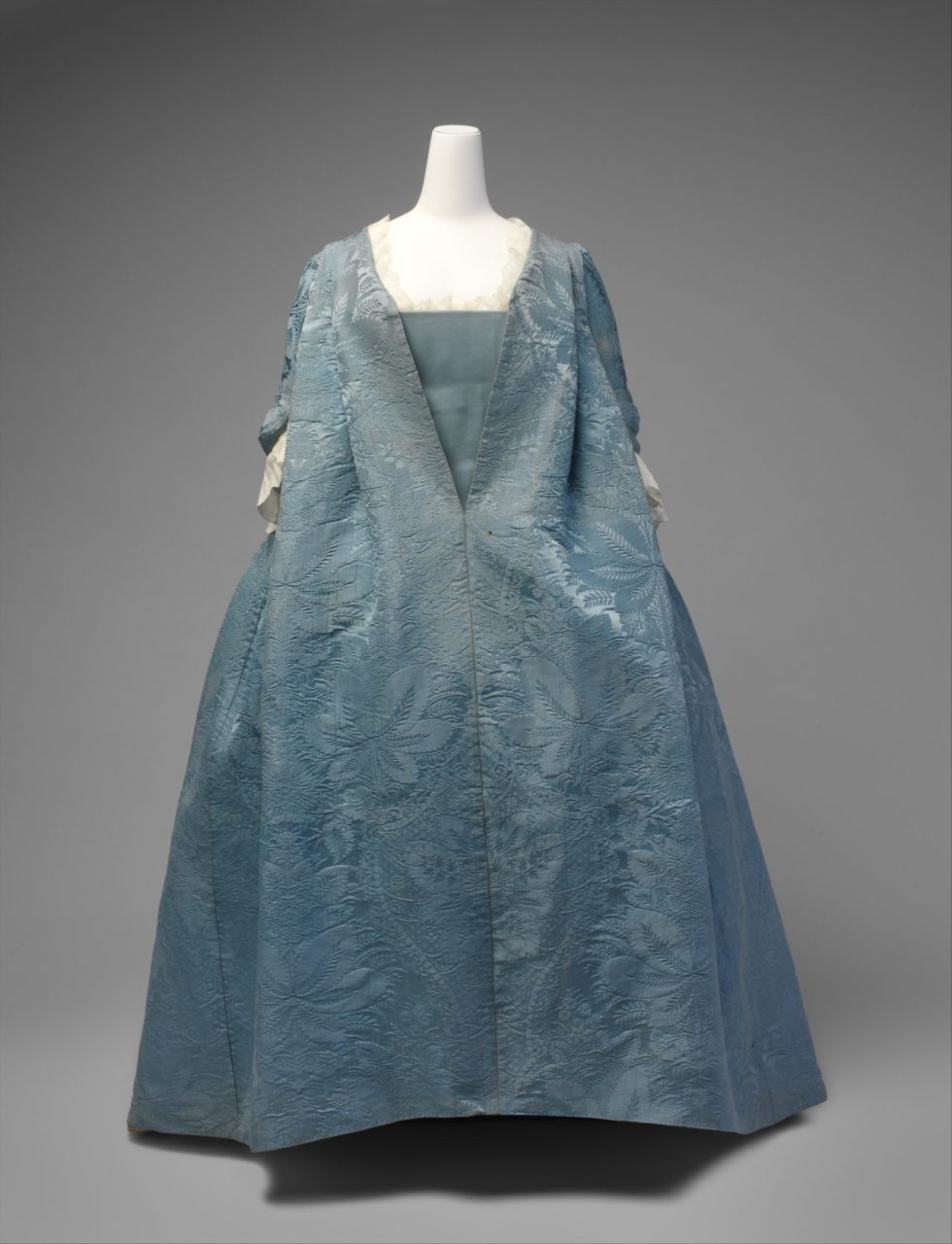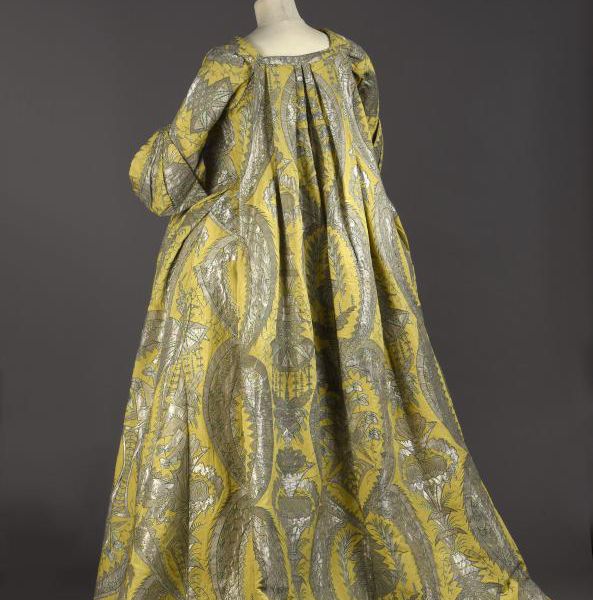A dress originating in 18th-century France which was pleated at the shoulder and hung loose down, worn over hoops.
The Details
Phyllis Tortora describes the robe volante in the Survey of Historic Costume (2015):
“Saque, robe battante, robe volante, and innocente are all names for a gown that was unbelted, loose from the shoulder to the floor. Made with pleats at the back and at the shoulder in front, sacques were worn over dome shaped hoops and might either have a closed front or be worn over a corset and petticoat.” (284)
Figure 1 from the Met features the back of a 1730 robe volante, clearly showing the back pleats and the volume of the dress. The front of the gown (Fig. 2) did not reveal the shape of the waist, but was embellished with a decorated stomacher (missing from the Met’s robe).
Daniel D. Hill describes the robe volante (under the definition: sack gown) in The History of World Costume and Fashion (2011):
“A flowing robe-like gown with a box pleat at the back neckline that fell loosely to the hem.” (455)
Charles Beard, C.W. and Phyllis Cunnington describes the robe volante (as a sacque dress) in A Dictionary of English Costume (1976):
“Originating from France and there worn earlier. The essential feature of the sack was the sack-back consisting of 2 box pleats, single double or treble, stitched down on each side of the back seam from the neck band to the shoulders and thence left loose to merge into the fullness of the skirt below.” (187)
Figure 3 is another example of the robe volante from the back, made from yellow damask fabric sewn with silver and green thread. Similar to figure 3, figure 4 is another version of the robe volante with elaborate floral patterns, which were popular in the 1730s.
Valerie Steele defined the robe volante in Paris Fashion: A Cultural History (2017) as:
“the robe volante or floating sack dress, a more negligee style, which the English found shocking. By the mid-eighteenth century, the sack dress then evolved into a form known throughout Europe as the robe à la française, which became more fitted, at least in front, with Watteau pleats hanging loosely down the back. The little bustle, characteristic of late seventeenth-century dress, was abandoned in favor of hooped petticoats called paniers, which extended on either side. Increasingly, the skirt was open in front to reveal a decorative petticoat that was part of the garment, while the front of the bodice displayed a triangular stomacher.” (31)
Figure 5 is an image of a robe volante from the front. In most cases, the stomacher would heavily embellished, with ribbons, embroideries and other details as seen in this image.
Smithsonian Magazine explained the robe volante’s appeal:
“The volante, or ‘flying dress,’ marked a transition away from the increasingly restrictive corseted dresses of the previous century. Joan de Jean, fashion expert and the author of The Age of Comfort, tells Stamberg that the dress was a reaction to previous styles in Louis XIV’s court. The obligatory fashions of the court were so over the top that women became weary of the costumes. ‘No one wants to get dressed up anymore,’ says de Jean. ‘Everyone just wants to be comfortable.'”
18th-century notions of comfort were different from today, however; the robe volante was still worn with a corset.
Fig. 1 - Designer unknown (French). Robe volante, ca. 1730. Silk. New York: The Metropolitan Museum of Art, 2010.148. Purchase, Friends of The Costume Institute Gifts, 2010. Source: The Metropolitan Museum of Art
Fig. 2 - Designer unknown (French). Robe volante, ca. 1730. Silk. New York: The Metropolitan Museum of Art, 2010.148. Purchase, Friends of The Costume Institute Gifts, 2010. Source: The Metropolitan Museum of Art
Fig. 3 - Designer unknown (French). Robe volante, 1730. Paris: Palais Galliera. Source: Smithsonian Magazine
Fig. 4 - Designer unknown (French). Dress and petticoat, 1730. Silk lampas. Boston: The Museum of Fine Arts, 43.664a-b. Gift of McCormick to the MFA. Source: MFA Boston
Fig. 5 - Designer unknown (French). Robe volante, 1735-40. Silk, flax. New York: The Metropolitan Museum of Art, 1983.399.1. Gift of Mary Tavener Holmes, 1983. Source: The Metropolitan Museum of Art
References:
- Cunnington, Cecil Willett, Charles Beard, and Phillis Cunnington. A Dictionary of English Costume: 900-1900. London: Black, 1976. http://www.worldcat.org/oclc/631404209
- Hill, Daniel Delis. History of World Costume and Fashion. Upper Saddle River, NJ: Pearson Prentice Hall, 2011. http://www.worldcat.org/oclc/731445106.
- Steele, Valerie. “The Birth of Paris Fashion.” In Paris Fashion: A Cultural History, 18–41. London: Bloomsbury Visual Arts, 2017. Accessed September 21, 2017. http://www.worldcat.org/oclc/1015183434.
- Tortora, Phyllis G., and Sara B. Marcketti. Survey of Historic Costume. Sixth edition. New York, NY: Fairchild Books, 2015. http://www.worldcat.org/oclc/1053943386.
-
“The Robe Volante, the First Comfortable Dress in France, Sells for $150,000 | Smart News | Smithsonian.” Accessed November 16, 2018. https://www.smithsonianmag.com/smart-news/robe-volante-first-comfortable-dress-france-sells-150000-180960089/.















